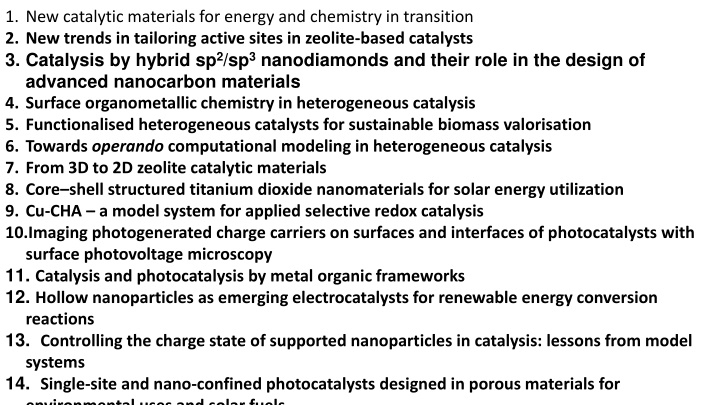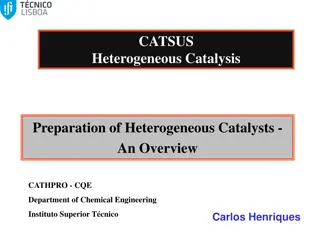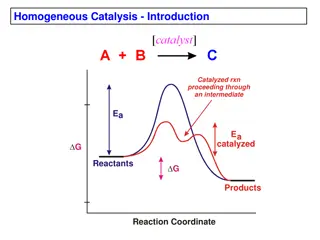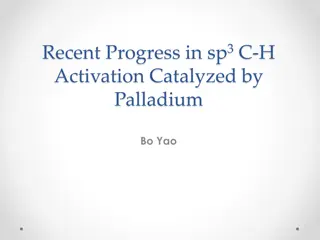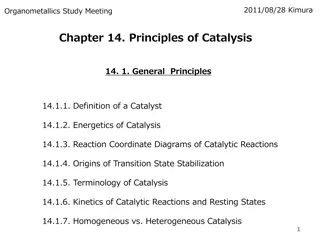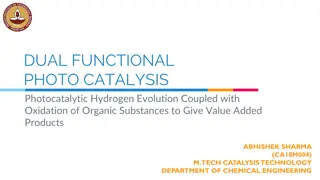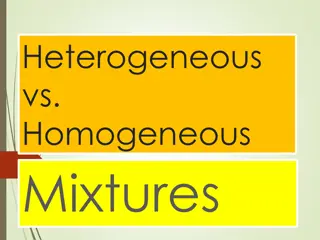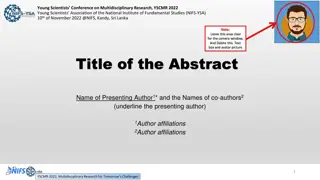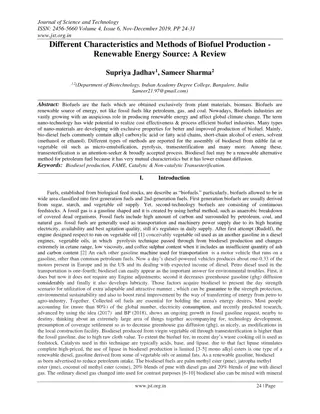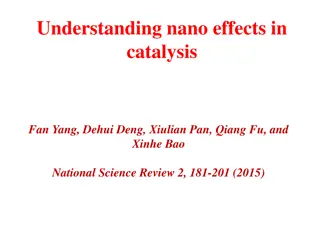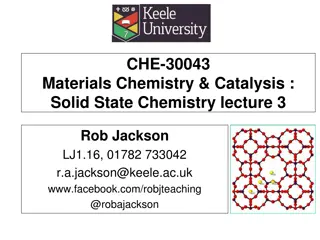Recent Advances in Heterogeneous Catalysis: A Multidisciplinary Approach
Heterogeneous catalysis is rapidly evolving with new materials and techniques, aimed at sustainability in energy and chemistry. This transition phase is driven by various factors, leading to critical challenges and opportunities in catalyst synthesis, characterization, theoretical understanding, and real-world applications. The field is highly multidisciplinary, focusing on sustainable solutions and addressing the changing landscape of chemistry and energy sectors.
Download Presentation

Please find below an Image/Link to download the presentation.
The content on the website is provided AS IS for your information and personal use only. It may not be sold, licensed, or shared on other websites without obtaining consent from the author.If you encounter any issues during the download, it is possible that the publisher has removed the file from their server.
You are allowed to download the files provided on this website for personal or commercial use, subject to the condition that they are used lawfully. All files are the property of their respective owners.
The content on the website is provided AS IS for your information and personal use only. It may not be sold, licensed, or shared on other websites without obtaining consent from the author.
E N D
Presentation Transcript
1. New catalytic materials for energy and chemistry in transition 2. New trends in tailoring active sites in zeolite-based catalysts 3. Catalysis by hybrid sp2/sp3 nanodiamonds and their role in the design of advanced nanocarbon materials 4. Surface organometallic chemistry in heterogeneous catalysis 5. Functionalised heterogeneous catalysts for sustainable biomass valorisation 6. Towards operando computational modeling in heterogeneous catalysis 7. From 3D to 2D zeolite catalytic materials 8. Core shell structured titanium dioxide nanomaterials for solar energy utilization 9. Cu-CHA a model system for applied selective redox catalysis 10.Imaging photogenerated charge carriers on surfaces and interfaces of photocatalysts with surface photovoltage microscopy 11. Catalysis and photocatalysis by metal organic frameworks 12. Hollow nanoparticles as emerging electrocatalysts for renewable energy conversion reactions 13. Controlling the charge state of supported nanoparticles in catalysis: lessons from model systems 14. Single-site and nano-confined photocatalysts designed in porous materials for environmental uses and solar fuels
Heterogeneous catalysis is also undergoing a significant transition phase, driven by a combination of pull and push factors. On one hand (pull factors), new objectives have been established in order to meet sustainability criteria, especially due to a new scenario in the chemistry and energy sectors, which will be discussed below. On the other hand (push factors), new tools have been developed to further understand synthesis procedures and catalyst properties. Thus, catalysis is rapidly evolving, as outlined in the recent Science and Technology Road-map of Catalysis for Europe
including the identification of critical challenges in the synthesis of different types of catalysts, their detailed characterisation, the theoretical description of catalyst properties and, last but not least, the real word of catalytic transformations. Thus, this themed issue is highly multidisciplinary, encompassing a wide range of approaches, yet describing in depth the characteristics of catalysis as a core interdisciplinary science at the interface between fundamental and applied research focused on sustainable
New scenario: chemistry and energy in transition The last major transition in chemistry occurred approximately 60 years ago with the introduction of petrochemistry Based on olefins and aromatics, which has remained in use to the present day. Most petrochemical processes are based on technologies developed then, albeit with improvements necessary to maintain production competitiveness. For example, the introduction of zeolites and their discovery and successful implementation has led to the substitution of harmful aluminium chloride and has supported phosphoric acid catalysts for petrochemical processes.
Petro-chemistry production is characterized by (i) a nearly exclusive use of fossil Resources both as raw materials and for heat production driving chemical transformations and separation processes, (ii) the concept of scale economy, e.g.,production costs do not increase linearly but rather exponentially (typically with an exponent of approximately 0.7) with plant size, thus leading to large-volume plants, and (iii) site integration, e.g. ,the creation of large petrochemical sites with multiple
Currently, this business model for industrial chemical production is facing many limitations regarding sustainability and local environmental impact, flexibility to variable demands, costs and restrictions in the transport of chemicals, and social acceptability, among other issues.
Until recently, the industry had focused on building larger plants, for example, for urea production (urea is perhaps the largest volume chemical and the basis of fertilisers), which expanded from standard to mega and then to jumbo plants (0.3 0.5, 1.0 1.3 and 3.5 4.2 Mt y 1 in a single line
Now, on the contrary, the possibility of distributed production, at a regional level, is under consideration. New plants with sizes one-to- two orders of magnitude smaller than standard plants are being designed, albeit using novel technologies efficient at a small scale and based on the use of alternative raw materials. In fact, most urea is actually produced from methane, which is the source of hydrogen necessary for N2 reduction to NH3 ,one of the key reactions in multistep and energy- intensive urea production. The concept of distributed production is primarily based on the use of local resources, for example, municipal waste, as C-source and as renewable energy
In the future, fully distributed production may be possible by directly using N2,H2Oand CO2 in an electrocatalytic process for on-site fertiliser production. Approximately 5 m2of photovoltaic panels could ideally produce fertilisers for 1 hec-tare, with a cost- competitive advantage, although electrocatalysts must still be developed.
Ongoing changes in society individuals are increasingly becoming both consumers and producers (they use and produce electrical energy, for example) require changes in business models, including chemical production; Increasing social awareness of environmental impacts and consequent opposition to large-scale plants integrated within large production sites; in these cases, the environmental impact surpasses the self-depuration capacity, progressively degrading the environment and adversely affecting biodiversity.
Reducing greenhouse gas (GHG) emissions is another key goal of this shift in industrial chemistry models. However, the main opponents to environmental policies advocate that economics should determine the shift from fossil to renewable resources because fossil fuels remain less expensive than alternative energy sources. Yet, the latest evidence no longer supports this claim. The recent report by the International Renewable Energy Agency8 shows that renewable energy will soon become less expensive than fossil fuels. Considering that most (up to 70 80%) of fossil fuels are used in petrochemistry to provide energy for chemical transformation, transitioning from fossil fuels to renewable resources is motivated by industrial competitiveness. This opens up the possibility to use renewable energy in combination with local C-resources (CO2 and waste, for example) to develop a new model of chemical production.
There are several other motivations for this transition: ensuring supply security, supporting local development, decoupling chemical production from the high volatility of fossil fuel prices and from fossil fuel monopolies and integrating chemical production with bio- economy (CO2 as the C-source should be derived from bioproduction, fermentation processes or biogas, for example), in addition to geopolitical reasons. All these motivations are driving the gradual transition from fossil fuels to alternative resources in energy and chemistry
Tailor-made synthesis for advanced nanoarchitectures and catalysts The optimisation of synthetic protocols and the discovery of new synthetic approaches are of the utmost importance for the development of new materials. While most synthetic procedures are usually based on the trial-and-error principle, recently developed knowledge based approaches or even theoretical predictions have been used to provide further scientific basis for the development of new catalysts. The portfolio of new catalysts is increasing substantially, bringing new advantages in performance and stability, e.g., novel two- dimensional systems,14 albeit without actual practical implications yet. In their review, Lee and his team focus on clean and sustainable energy conversion systems, which primarily require the development of highly efficient catalysts with maximum performance. They discuss hollow nanostructures, including nanocages and nanoframes, identifying them as promising electrocatalysts. The authors describe recent advances in synthetic methods for noble metal-based hollow nanostructures based on thermodynamic and kinetic approaches with electrocatalytic applications of these materials in ORR, OER, and HER reactions. In addition to introducing synthetic strategies for hollow structures,.
New concepts and opportunities from fundamental to applied perspectives Accelerating this transition in energy and chemistry requires putting more effort into developing new concepts and approaches in heterogeneous catalysis. Even new areas such as water splitting and CO2 conversion often lack originality and overlook crucial aspects. Knowledge on synthesis, modelling and characterisation must be creatively applied to catalyst design from new perspectives. The reviews included in this section highlight the most exciting developments in this direction. Three reviews are dedicated to the topic of increasing the relevance of photocatalysis. Yamashita and colleagues, in collaboration with Che, examine the possibilities offered by single-site and nanoconfined photocatalysts (particularly based on Ti), in contrast to conventional photocatalysts based on semiconductors. In their review, the authors discuss the opportunities provided by photoactive functional materials prepared by taking advantage of the empty spaces of porous ordered materials. These properties are greatly affected by the coordination structure and by the reaction field environment (hydrophilicity/hydrophobicity and electrostatic fields, among other factors) near the active species. Those materials open new possibilities for unique activity and selectivity, in contrast to conventional semiconducting Photocatalysts
Catalysis is the core and essential factor for the success of this transition in the fields of energy and chemistry.
